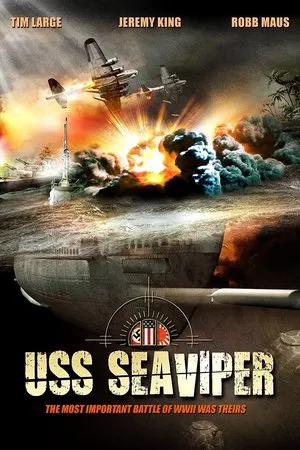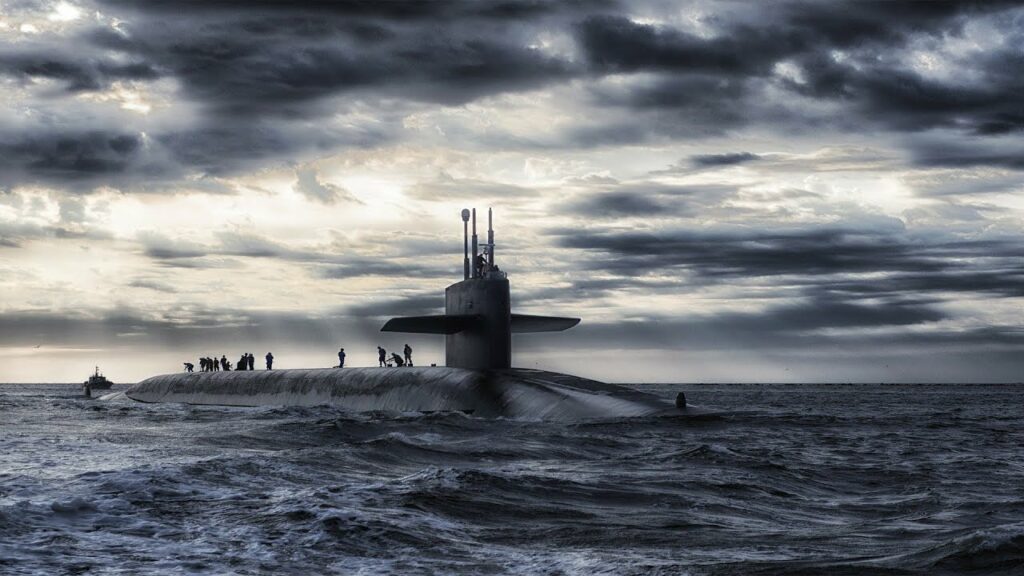Introduction: Unveiling USS Seaviper (2012) and its Director

USS Seaviper, released in 2012, is an independent feature film belonging to the action, drama, and war genres. It presents a fictional narrative centered around the crew of a United States submarine during World War II, tasked with a perilous mission in the Pacific theater. The film was directed, produced, and reportedly co-written by Ralph A. Villani through his production company, Mighty Moments Motion Pictures, in association with Villani Rockhill Productions.
A defining characteristic of the film’s production is its use of an authentic historical artifact as its primary setting: the Gato-class World War II submarine, USS Drum (SS-228). Now preserved as a museum ship in Mobile, Alabama, the choice of the USS Drum transcends mere set dressing; it holds a deep personal resonance for the director. Ralph A. Villani’s father, P.J. Villani, served aboard the actual USS Drum during the war. This familial connection imbues the project with a layer of personal significance, suggesting a motivation beyond typical filmmaking aspirations and likely influencing both the choice of subject matter and the unique filming location.
It is crucial to establish from the outset that the submarine “USS Seaviper” depicted in the film is entirely fictional. No vessel bearing this name exists in the official historical inventory of the United States Navy, as confirmed by checks against the Naval Vessel Register (NVR) resources. Further potential confusion arises from the name “Sea Viper,” which is the designation for a modern anti-aircraft and anti-missile warfare system employed by the British Royal Navy’s Type 45 destroyers. This system is entirely unrelated to the World War II setting and fictional submarine of the film. Additionally, the name Ralph A. Villani is shared by other public figures, most notably a former Mayor of Newark, New Jersey. Subsequent sections of this report will carefully disambiguate the filmmaker from these other individuals to ensure clarity. This introduction serves to frame USS Seaviper within its independent production context, highlighting the unique and personally significant filming location while proactively addressing potential ambiguities surrounding the vessel’s name and the director’s identity.
Inside the Film: USS Seaviper (2012)
Detailed Plot Synopsis
The narrative of USS Seaviper unfolds in September 1944. The fictional submarine USS Seaviper, under the command of Captain Horatio Culpepper, receives top-secret orders originating from President Roosevelt via Vice Admiral Stallerman. The initial mission is to rescue the crew of a downed American aircraft near the island of Sumatra. During the rescue, the Seaviper crew recovers the American pilot along with two escaped Allied prisoners-of-war.
Their reconnaissance reveals a startling development: German and Japanese forces are collaborating on the island. Specifically, they discover that the Germans have repurposed a Type IXD2 U-boat, U-234 (historically a real submarine known for its attempted voyage to Japan with advanced technology near the war’s end, though the film takes liberties with its role and cargo), converting the mine-layer into a long-range transport. This U-boat is allegedly carrying a dangerous cargo, identified in some plot summaries as Uranium-235 (U-235), intended for delivery to the Japanese, hinting at a potential atomic weapon component or other “Ultimate Weapon”. The Seaviper‘s mission evolves into locating and intercepting this critical exchange.
The plot introduces significant internal conflict when Captain Culpepper must go ashore for reconnaissance, leaving the submarine temporarily under altered command. The Executive Officer (XO), Roitman, sustains a head injury during a depth charge attack by a Japanese destroyer and is relieved of duty. Command devolves to Officer Cutter, depicted as a rival to the Chief of the Boat, Chief Keenan. This sets up a power struggle, as Cutter defies the Captain’s orders to maintain position for rendezvous, creating friction with Chief Keenan who advocates adherence to command.
The crew faces escalating external and internal perils. They are hunted by a Japanese destroyer, trapping them beneath the surface. The submarine suffers from decreasing oxygen levels, damage from depth charges, a flooded compartment, and a perilous situation with a torpedo stuck in its tube. With limited high-pressure air reserves barely sufficient to reach a safer depth, the crew must overcome internal strife and external threats to survive and potentially thwart the enemy’s plan.
Narrative Analysis
USS Seaviper employs several familiar tropes common to the submarine war film subgenre. The claustrophobic setting of the submarine interior inherently generates tension. The narrative leans heavily on internal command conflict, pitting the by-the-book Chief Keenan against the seemingly insubordinate Officer Cutter, a classic dramatic device in military stories. External threats manifest as the relentless Japanese destroyer and the perils of underwater warfare, including depth charges and potential structural failure. Technical malfunctions, such as the stuck torpedo and flooding, add layers of jeopardy, forcing the crew into problem-solving under extreme pressure. The specific plot element involving German-Japanese collaboration on a secret weapon exchange in the Pacific serves as the primary narrative catalyst, driving the mission’s urgency and stakes, although its historical plausibility regarding U-234’s cargo and mission timing is adapted for dramatic effect.

Production Specifics
The film was produced with an estimated budget of $3,000,000. This figure places it firmly in the category of low-to-modest budget independent filmmaking, particularly for a period piece involving specialized sets and action sequences. Production was handled by Villani Rockhill Productions and Mighty Moments Motion Pictures , the latter being director Ralph A. Villani’s own company.
Classified under the genres of Action, Drama, and War , the film’s runtime is reported with some inconsistency across sources, listed as 1 hour 42 minutes (102 minutes) , 89 minutes , or 93 minutes. Technical specifications include a widescreen aspect ratio of 2.35:1 and a Dolby Digital sound mix. Distribution appears to have been limited, typical for independent films, involving festival screenings and home video releases, with specific mentions of PAL Region 2 DVDs for the UK/European market , alongside some potential streaming availability.
Key Cast and Characters
The main cast members and their roles include :
- Tim Large as Chief Keenan
- Jeremy King as Officer Cutter
- Robb Maus as Executive Officer Roitman
- Steve Roth as Captain Culpepper
- Michael Jacques as Grey
- Nick Schroeder as Muley
- David D’Onofrio as Bartimeo
- J. Mark Emerson as Betts
- Jordan Wall as Lewis
- Tyler Cross as Kashavsky
- David Yuzuk (as David Danello) as Grease
- Ralph A. Villani (the director) appears in the role of Vice Admiral
The USS Drum (SS-228): A Historic Set Piece
The decision to film aboard the USS Drum (SS-228) is perhaps the most distinctive aspect of USS Seaviper‘s production. The USS Drum is a Gato-class submarine, commissioned by the US Navy on November 1, 1941. It had a decorated service record in World War II and is now preserved as a National Historic Landmark and museum ship at Battleship Memorial Park in Mobile, Alabama.
Utilizing an authentic WWII submarine provided a level of realism and atmosphere difficult to replicate on a constructed set, especially within the constraints of an independent film budget. Director Ralph Villani explicitly noted that using the genuine naval vessel would lend authenticity to the cinematic story. However, filming on location presented unique challenges. Production reportedly took place at night, allowing the museum to remain open for tourists during daytime hours. This logistical constraint likely added complexity to the shooting schedule. The use of the Drum not only grounds the fictional story in tangible history but also serves as a direct link to the director’s personal family history, adding considerable depth to the production’s backstory.
The Filmmaker: Ralph A. Villani
The director, producer, and co-writer associated with USS Seaviper is Ralph A. Villani, a figure with a background in independent film and theatre. It is essential to focus on this individual, distinct from others sharing the same name.
Biographical Sketch
Based on available profiles, Ralph A. Villani is identified as an actor, producer, director, writer, and musician. His professional background includes attending New York Film School and subsequently working at Columbia Pictures for five years. He possesses significant theatre experience, having served as the Artistic Director for Bravado Theatre Company in New York City and Florida. His training includes studies with notable institutions like the New Group Theatre, the Tribecca Drama Institute, Piera Dusa Studio, and HB Studios in New York City. Furthermore, he served on the Board of Directors for Theatre Gym in NYC and has directed and acted in stage productions in both New York and Florida. Villani also has experience as an acting teacher, focusing on Stanislavski, Meisner, and Adler methods, and taught for three years at the Burt Reynolds Institute in Jupiter, Florida. He is reportedly based in Florida.

Film Career and Mighty Moments Motion Pictures
Ralph A. Villani operates through his production company, Mighty Moments Motion Pictures, which focuses on independent projects. His notable film credits include:
- USS Seaviper (2012): Served as Director, Producer, and appeared as Vice Admiral. Some sources also list him as a writer.
- 228 Stories From The USS Drum (2016): A documentary video focusing on the history and crew stories of the USS Drum. Villani served as Director and Producer. This project further underscores his connection to the historic submarine.
- One Zero Zero and Closing: Listed as an upcoming project in pre-production where he is a producer. However, other sources mention a film with this title winning a Telly Award in 1999, suggesting either a remake, a long development period, or confusion in reporting.
- Crying Whispers (1997): A feature film he produced and directed, which received a Silver Award at the Philadelphia Film Festival.
Beyond his directorial and production work, Villani has accumulated acting credits, often in minor or uncredited roles, in films such as New York November (2011), City Hall (1996), Die Hard with a Vengeance (1995), and the TV series The City (1996). He also appeared in the Austrian film “The Orange Paper,” screened at Cannes in 2004.
The Personal Connection: P.J. Villani’s Legacy
A pivotal factor in understanding Ralph A. Villani’s work, particularly USS Seaviper and the subsequent documentary, is his direct familial link to the USS Drum. His father, identified as P.J. Villani, served as a crew member on the USS Drum during World War II, specifically during what would have been its 14th war patrol. This profound personal connection almost certainly served as a primary inspiration for choosing the Drum as the filming location for USS Seaviper, lending the project a layer of homage and personal investment. The creation of the documentary 228 Stories From The USS Drum years later further solidifies this connection, suggesting a sustained interest in preserving and sharing the history of the vessel his father served upon. This connection elevates his film projects related to the Drum beyond mere historical fiction or documentation, framing them as acts of remembrance and familial tribute.
Clarifying Identities: The Ralph A. Villanis
The shared name “Ralph A. Villani” necessitates careful disambiguation to avoid confusing the filmmaker with other individuals documented in the research materials. The evidence clearly points to at least three distinct people.
- Ralph A. Villani (Filmmaker): This is the individual central to the discussion of USS Seaviper. Key identifiers include his profession as a director, producer, writer, actor, and musician active in film and theatre from at least the 1990s through the 2010s. His notable works are USS Seaviper (2012) and 228 Stories From The USS Drum (2016). He has connections to New York Film School, Columbia Pictures, and is based in Florida. His father, P.J. Villani, served on the USS Drum.
- Ralph A. Villani (Mayor of Newark): A prominent political figure in New Jersey history. Born Raffaele A. Villani in Elizabeth, NJ, on September 11, 1901, he died on February 27 or 28, 1974. He was the son of Italian immigrants Carmine and Anna Villani. A Republican, he served as a Newark City Commissioner, directed the Department of Parks and Public Property (credited with planting thousands of trees), was Mayor of Newark from 1949 to 1953, and later served as an at-large City Councilman until shortly before his death. He faced legal challenges during his career, including charges of improper conduct as a judge (later overturned) and accusations of receiving kickbacks while Mayor. He was married first to Teresa Galante (d. 1964) and later to Marie Sicconolfi Juliano. His life and career are well-documented in Newark historical archives. The timeline of his life (1901-1974) makes it impossible for him to be the director of a 2012 film.
- Rev. Ralph A. Villani: An obituary documents a third individual, Rev. Ralph A. Villani, born May 3, 1943, in the Bronx, NY, and died February 2, 2008. He was a Catholic priest ordained in 1968, holding degrees from St. Joseph’s College & Seminary, the Pontifical Gregorian University in Rome, and Rutgers University. His career involved pastoral assignments and faculty positions at high schools primarily in New York and New Jersey. His profession and lifespan clearly distinguish him from both the filmmaker and the mayor.
Table: Comparative Biographical Details
The following table provides a concise comparison to definitively separate these three individuals:
| Feature | Ralph A. Villani (Filmmaker) | Ralph A. Villani (Mayor) | Rev. Ralph A. Villani |
|---|---|---|---|
| Profession | Film Director, Producer, Writer, Actor, Musician | Politician (Mayor of Newark, Commissioner, Councilman) | Catholic Priest |
| Key Work | USS Seaviper (2012), 228 Stories From USS Drum (2016) | Mayor of Newark (1949-1953) | Pastoral/Faculty Roles |
| Lifespan | Active 1990s-2016+ (Birthdate not provided) | 1901 – 1974 | 1943 – 2008 |
| Location | Florida based (Stuart, Jupiter) | New Jersey (Elizabeth, Newark) | New York / New Jersey |
| Key Context | Independent Film, USS Drum | Newark Politics, Italian-American History | Catholic Church |
This systematic comparison, drawing on distinct biographical details, professions, timelines, and associated contexts found in the source materials, effectively resolves any potential identity confusion. The focus of this report remains squarely on Ralph A. Villani, the filmmaker.
Critical Lens: Reception and Audience Feedback
The critical reception of USS Seaviper appears to be mixed and generally reflects the trajectory of many low-budget independent films attempting ambitious genre storytelling. Online user ratings are notably low, with IMDb showing a score of 2.4 out of 10 and FilmAffinity recording a 3.3 out of 10 based on 38 ratings. (Access to Rotten Tomatoes and Mubi was not available to confirm scores there ).
Analysis of available user reviews reveals a polarized response:
- Positive Feedback: One detailed Amazon review praised the film, highlighting “first class” acting and the authenticity lent by filming on the real USS Drum. This reviewer drew a favorable comparison to the acclaimed submarine film Das Boot and indicated enjoyment among a group viewing at a film festival. This suggests the film resonated with some viewers, potentially those with an interest in WWII history, submarines, or appreciating the effort involved in the independent production.
- Negative Feedback: Conversely, another Amazon review described the viewing experience as “painful,” harshly criticizing the acting as “marginal,” the plot as “childish,” and the CGI effects. This reviewer lamented the perceived decline in quality WWII films and felt USS Seaviper was a “huge flop”. Another critical point raised in a separate review focused on the film’s low-budget appearance, specifically citing inaccuracies in uniforms, such as a captain meeting an admiral wearing dress whites devoid of rank insignia or ribbons. Plot inconsistencies or goofs were also noted, for example, a discrepancy in the reported range of an enemy destroyer versus the submarine’s movement.
These criticisms regarding acting, plot, effects, and production value details like costumes are common challenges faced by independent films operating with limited financial resources, especially when tackling period settings and action sequences. The estimated $3M budget likely constrained the filmmakers’ ability to achieve the polish and scale expected in mainstream war films.
Despite the mixed reviews and low aggregate scores, USS Seaviper achieved recognition within the independent film festival circuit, securing several awards :
- Best Florida Film at the Cenflo Film Festival in Orlando.
- Best Audience Choice Feature Film at the Vegas Cine Fest.
- Best Picture, Best Screenplay (Lynanne Rockhill), and Best Cinematography at the Treasure Coast International Film Festival.
- Nominations for Best Director (Ralph A. Villani) and Best Editor at the Treasure Coast International Film Festival.
While IMDb lists a more modest “1 win & 1 nomination total” for the film and “1 win total” for Villani personally , the list compiled from Villani’s professional profile indicates broader success at these specific festivals. This pattern suggests the film found appreciation among festival juries and audiences within its specific niche, even if it failed to garner widespread critical acclaim or high marks from general online reviewers. The reception landscape thus reflects its status as an independent work – facing production limitations but achieving niche recognition, particularly valued for its unique setting and the personal story behind its creation.
Conclusion: Situating USS Seaviper and Ralph A. Villani
USS Seaviper (2012) stands as a noteworthy example of independent filmmaking tackling the demanding genre of the World War II submarine film. Directed by Ralph A. Villani, the film presents a fictional narrative but gains significant distinction through its primary filming location: the authentic WWII submarine USS Drum (SS-228), now a museum ship.
Crucially, this analysis has clarified the identity of the filmmaker, Ralph A. Villani, distinguishing him definitively from other public figures bearing the same name, particularly the former Mayor of Newark, NJ, Ralph A. Villani (1901-1974), and Rev. Ralph A. Villani (1943-2008). The filmmaker’s background in theatre and independent film production, combined with a deeply personal motivation, shaped this project. His father, P.J. Villani, served aboard the very submarine used for filming, the USS Drum. This connection strongly suggests that USS Seaviper, along with Villani’s subsequent documentary 228 Stories From The USS Drum , represents more than just a cinematic endeavor; it is likely an act of personal tribute and historical remembrance.
Positioned within the context of low-budget independent cinema, USS Seaviper‘s strengths and weaknesses become clearer. Its use of the USS Drum provided unparalleled authenticity and atmosphere , a unique production value compensating for potential limitations elsewhere. However, the film’s modest estimated budget of $3 million likely contributed to the mixed critical reception, with criticisms directed at production elements such as visual effects and costume accuracy. Nevertheless, the film garnered multiple awards at regional and niche film festivals, indicating appreciation within the independent film community. Its distribution appears to have followed a typical path for such productions, relying on festival screenings and home video/streaming markets.
In final consideration, USS Seaviper is best understood as a passion project. While its execution garnered mixed responses, its significance lies in its unique setting aboard a historic vessel and the powerful personal story connecting the director to that vessel’s legacy. It serves as a testament to the drive of independent filmmakers to tell stories of personal importance, leveraging unique resources like the USS Drum to bring their vision to the screen, even amidst budgetary constraints.

